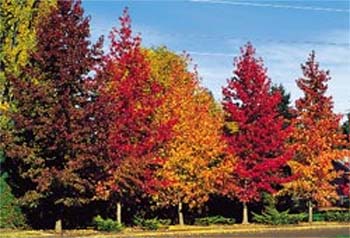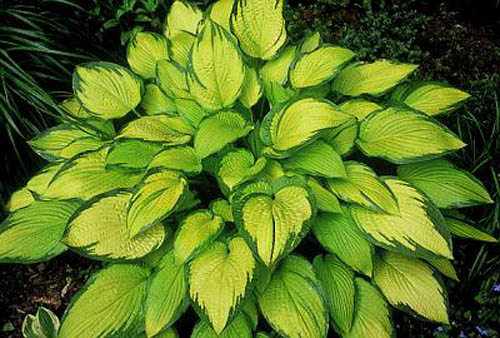No other flower heralds the arrival of Spring in Southwestern Lower Michigan like the first blooming daffodil. There are a number of Spring blooming flowers but the daffodil stands in a class of it’s own. There just is nothing like waking up in the morning with that first cup of coffee in hand and walking into a garden surrounded by the warm yellow glow provided by early jonquils.
We just cannot use enough daffodils in our gardens. We have them naturalized throughout our woodlands, planted in formal raised beds, scattered amongst the perennials, and even in pots and containers. All 13 divisions are well represented in our gardens. You will find varieties from the large trumpet classics Dutch Master or King Alford down to the petite mini Chit Chat.
While our favorite color is the classic bright yellow of the large cupped Camelot, you will also find the whites and pinks well represented. We use the white, small cupped daffodil, Polar Ice in large numbers mixed with the hellebores . Also, Ambergate, with it’s brick red cup is a real eye catcher along the front walk. Every year a few of the pinks, such as Chinese Carol, find their way into the gardens.
There is just something magical about daffodils. Each Fall you plant all of these ugly brown things in the ground, quickly forget about them, and in the Spring out pops these gorgeous blooms. For, us daffodils provide a never ending Adventure in Wonderland.
Last Fall we added to our adventure by planting the following varieties in our gardens:

Colblanc – has a pure, snow white flower with a ‘green eye’ that looks like something grown in the tropics. It is 14 to 16 inches tall, a midseason bloomer.
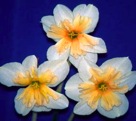
Apricot Lace – a Brent and Becky original grown seedlings from ‘Palmares’ and “Jonquilla’, with great qualities of each parent. It blooms in mid-late spring with the flowers being held on 12-18 inch stems.

Avalanche – has 15-20 white petals and a demitasse-shaped cupped, sweetly fragrant flowers on 16 – 18 inch stems, an early to mid season bloomer.
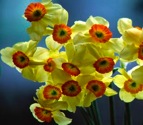
La Belle – is little 6-10 inch intermediate flowering daffodil that brightens up the garden in late to mid Spring.
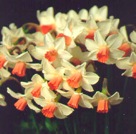
Kaydee – the pinkest of the midseason cyclaminius, its white petals enhance the vivid salmon pink cup, 10-12 inches tall.
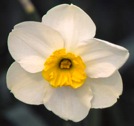
Jamestown – a beautiful, late-mid Spring, 14-16 inch tall daffodil that really stands out in the garden.
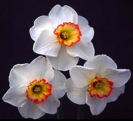
Barbie Doll – an intermediate sized mid – Spring daffodil that performs along walks.
Whatever division, color, or size you choose, you will not be disappointed by the daffodil. Make sure you choose several varieties that bloom at different times to insure continually supply of fresh blooms.
Tips of the Month
Daffodils are classified by the The American Daffodil Society into one of the thirteen divisions described below:
- Division 1 – One flower to a stem, trumpet or cup as long or longer than the perianth segments.
- Division 2 – One flower to a stem, cup more than one third but less than equal to the length of the perianth segments.
- Division 3 – Short cup have one flower to a stem, cup not more than one third the height of the perianth segments.
- Division 4 – Double daffodils have a clustered cup, petals or both. There can be one or more flowers per stem.
- Division 5 – These usually have more than one flower to a stem, head drooping, perianth segments often reflexed and of silky texture.
- Division 6 – Have one flower to a stem, perianth significantly reflexed and corona straight and narrow.
- Division 7 – Usually have several flower heads to a stem, flowers usually fragrant, stem is round in cross-section and foliage is often rush like.
- Division 8 – Usually three to twenty flowers to a stout stem, sweet scented and very short cupped. Perianth segments rounded and often somewhat crinkled.
- Division 9 – Have one flower to a stem. White petals sometimes stained with the corona color at the base, small flat cup edged with red.
- Division 10 – Small flowers resemble a “hoop petticoat” form.
- Division 11 – Corona split for at least one third of its length. Split-corona daffodils with the corona segments opposite the perianth segments, the corona segments are usually in two whorls of three.
- Division 12 – Daffodils not falling into any of the previous categories.
- Division 13 – All species and reputedly wild forms.
Flower of the Month
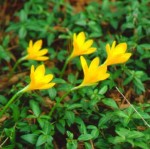
Sternbergia hybrid “Autumn Daffodil”
It is a terrific bulb to use in naturalizing. They have bright yellow, crocus-like flowers that pops up out of nowhere. Grow in partial shade for autumn color. These bulbs must be dug and stored each fall where killing frost in colder climates.
Web Site
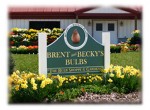 Brent and Becky’s Bulbs are a hybridizers of daffodils. They are third generation bulb growers, growing many unusual and specialty bulbs on their ten acre farm in Gloucester, Virginia. They offer a wide selections of the bulbs species, from old favorites like Dutch Master to new introductions, such as Katie Heath.
Brent and Becky’s Bulbs are a hybridizers of daffodils. They are third generation bulb growers, growing many unusual and specialty bulbs on their ten acre farm in Gloucester, Virginia. They offer a wide selections of the bulbs species, from old favorites like Dutch Master to new introductions, such as Katie Heath.
